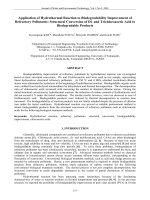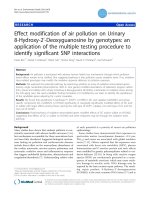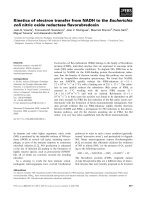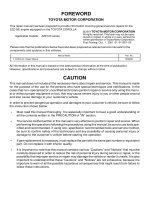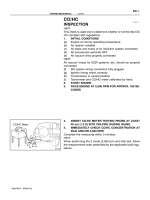Conversion of the engine from diesel to gas (CNG LPG) Hướng dẫn chuyển đổi động cơ diesel sang CNG
Bạn đang xem bản rút gọn của tài liệu. Xem và tải ngay bản đầy đủ của tài liệu tại đây (16.77 MB, 193 trang )
NGV 2700 CONVERSION KIT
GENERAL MANUAL
Index
INDEX
Pagina 1 di 4
SECTION 01 – PRELIMINARIES CONTROLS ON THE ENGINE
01.01 DISASSEMBLY OF THE ENGINE
01.02 ENGINE COMPONENTS CHECK
SECTION 02 – WORKING ON THE ORIGINAL DIESEL
COMPONENTS
02.01 CYLINDER HEAD
02.02 PISTON
02.03 INLET MANIFOLD
02.04 TEMPERATURE SENSOR SEAT
02.05 LAMBDA SENSOR SEAT
02.06 ORIGINAL OIL PIPES
02.07 DIESEL PUMP SUPPORT MODIFICATION
02.08 RADIATOR CAP
SECTION 03 – ENGINE REASSEMBLY
03.01 ENGINE REASSEMBLY
SECTION 04 – VALVES GAP MODIFICATIONS
04.01 VALVES GAP MODIFICATIONS
SECTION 05 – CONVERSION KIT COMPONENTS INSTALLATION
05.01 TOOTHED WHEEL
05.02 REVOLUTIONS SENSOR
05.03 REVOLUTIONS SENSOR SETTINGS
05.04 COILS
05.05 SPARK PLUGS
05.06 THROTTLE VALVE
05.07 MIXER
05.08 SPARK PLUG CABLES
Conversion of the engine – from Diesel to GAS (cng/lpg)
Index
INDEX
05.09 WATER TEMPERATURE SENSOR
05.10 REDUCER
05.11 GAS LINE
05.12 LAMBDA SENSOR
05.13 PRESSURE DISCHARGING LINE
05.14 ENGINE HARNESS
05.15 ECU
05.16 DIAGNOSIS SYSTEM
05.17 ECU HARNESS
SECTION 06 – ECU CONFIGURATION
06.01 ECU-PC CONNECTION
06.02 PARAMETERS TO SET
06.02.01 TOOTHED WHEEL TYPE
06.02.02 ON 2 ENGINE REVOLUTIONS
06.02.03 NUMBER OF CYLINDERS
06.02.04 24V – 12V
06.02.05 RPM. OVERRUN THRESHOLD
06.02.06 OPTION DEFAULT STUCK
06.02.07 TYPE OF LAMBDA PROBE
06.02.08 NUMBER OF LAMBDA PROBES
06.02.09 CUTOFF OPTION
06.02.10 LEVEL SENSORS
06.02.11 PRESSURE CONTROL
SECTION 07 – SWITCH ON THE ENGINE – CONTROL
07.01 TIMING ADVANCED
07.02 IDLE ENGINE REVOLUTIONS
07.03 LAMBDA SENSOR
07.04 TEMPERATURE SENSOR
07.05 TPS
07.06 THROTTLE VALVE IDLE
Conversion of the engine – from Diesel to GAS (cng/lpg)
Pagina 2 di 4
Index
INDEX
SECTION 08 – ROAD TEST
08.01 MODALITY
08.02 TEST CONTROLS
08.03 END TEST CONTROLS
SECTION 09 – DELIVERY FOR CUSTOMERS
09.01 INFORMATIONS FOR CUSTOMERS
SECTION 10 – TROUBLE SHOOTING
10.01 TROUBLE SHOOTING
10.02 ERROR CODE MANUAL
10.03 FLOW CHART
10.03.01 THE ENGINE IS NOT STARTING
10.03.02 THE ENGINE SUPPLIES NOT ENOUGH POWER
10.03.03 THE ENGINE RUNS UNEVENLY
10.03.04 BACKFIRINGS
10.04 CONTROLS
10.04.01 COMPRESSION TEST
10.04.02 VALVES GAP
10.04.03 SPARK PLUGS
SECTION A1 – STANDARD COMPONENTS
A1.01 LAMBDA SENSOR HOUSING
A1.02 LAMBDA SENSOR
A1.03 TOOTHED WHEEL TYPES
A1.04 REVOLUTION SENSOR
A1.05 ECU
A1.06 COIL
A1.07 THROTTLE VALVE FLANGE
A1.08 THROTTLE VALVE
A1.09 MIXER
A1.10 TEMPERATURE SENSOR
A1.11 SPARK PLUG CABLE
Conversion of the engine – from Diesel to GAS (cng/lpg)
Pagina 3 di 4
Index
INDEX
A2 HARNESS
A2.01 ECU HARNESS
A2.01.01 HARNESS DRAWING
A2.01.02 FUNCTIONAL DRAWING
A2.01.03 PIN – OUT
A2.02 4 CYLINDERS ENGINE HARNESS
A2.02.01 HARNESS DRAWING
A2.02.02 FUNCTIONAL DRAWING
A2.02.03 PIN – OUT
A2.03 6 CYLINDERS ENGINE HARNESS
A2.03.01 HARNESS DRAWING
A2.03.02 FUNCTIONAL DRAWING
A2.03.03 PIN – OUT
A2.04 8 CYLINDERS ENGINE HARNESS
A2.04.01 HARNESS DRAWING
A2.04.02 FUNCTIONAL DRAWING
A2.04.03 PIN – OUT
Conversion of the engine – from Diesel to GAS (cng/lpg)
Pagina 4 di 4
PRELIMINARIES CONTROLS ON
THE ENGINE
Section 01
01.01 DEASSEMBLY OF THE ENGINE
01.02 ENGINE COMPONENTS CHECK
01.01 DISASSEMBLY OF THE ENGINE
PHASE DESCRIPTION
01
Disassemble the original engine head.
02
Disassemble the original valves.
03
Disassemble the original camshaft.
04
Disassemble the original crankshaft.
05
Disassemble the original bearings.
06
Disassemble the original pistons.
07
Disassemble the original piston rings.
08
Disassemble all the original diesel feeding system.
Conversion of the engine – from Diesel to GAS (cng/lpg)
Page 1 of 1
01.02 ENGINE COMPONENTS CHECK
Page 1 of 1
PHASE DESCRIPTION
01
Check the conditions of the valves.
02
Check the conditions of the valve seats.
03
Check the conditions of the camshaft.
04
Check the conditions of the crankshaft.
05
Check the conditions of the original block bearings.
06
Check the conditions of the original connector rod bearings.
07
Check the conditions of the original pistons.
If the components previously checked are damaged, replace or repair them (the crankshaft and the
camshaft can be refaced).
Conversion of the engine – from Diesel to GAS (cng/lpg)
ORIGINAL DIESEL
COMPONENTS MODIFICATIONS
Section 02
02.01 CYLINDER HEAD
02.02 PISTON
02.03 INLET MANIFOLD
02.04 TEMPERATURE SENSOR SEAT
02.05 LAMBDA SENSOR SEAT
02.06 ORIGINAL OIL PIPES
02.07 DIESEL PUMP SUPPORT MODIFICATIONS
02.08 RADIATOR CAP
Section 02 – Working On The Original Diesel Components
02.01 CYLINDER HEAD
Page 1 of 4
PHASE DESCRIPTION
The engine head modifications are necessary to be able to replace the original diesel injectors with
the adequate spark plugs.
01
Disassemble the original cylinder head.
02
Measure the diameter of the original injector seat (D picture 01), in order to chose the type
of spark plug (the thread): if the original diameter is 9 mm or less, it is possible to use a
spark plug with the thread M10x1; if the diameter is bigger, until to 10,75 mm diameter, it
must be used a spark plug with the thread M12x1,25.
03
Verify the length L (picture 01), in order to chose the type of spark plug (length of the
thread). Consider that when the spark plug is completely screwed in the seat, the only part
of it that must enter in the combustion chamber is the electrode, as shown in the picture 02.
picture 01 – ORIGINAL ENGINE HEAD
picture 02 – ELECTRODE IN THE COMBUSTION CHAMBER
Conversion of the engine – from Diesel to GAS (cng/lpg)
Section 02 – Working On The Original Diesel Components
02.01 CYLINDER HEAD
Page 2 of 4
PHASE DESCRIPTION
IMPORTANT: the workings that are following described ,must be coaxial with the original injectors
seats; in case make an apposite tool to guarantee the coaxial.
04
Verify that near the original injector seat there aren’t some oil or water conduits. If there
are, check if machining the original seat to enlarge it (minimum 22 mm), in order to allow
the passage of the spark plug wrench, the conduits aren’t broken. The distance between the
modified seat and the water or oil conduits must be not less than 4 mm. If the distance is
less than 4 mm is preferable use the adequate spark plug bushing (see the end of the
paragraph). See the picture 03. The water or oil conduits there could be in the position
shown by the arrows too.
water or oil conduits
picture 03 – CONDUITS DISTANCE
05
After the choice of the type of the spark plug (thread diameter and thread length), enlarge
(if it is necessary) the hole indicated in the picture 04. Verify that the spark plug seat isn’t
too near to the valves seats (see the picture 05).
Ø 9 for M10x1
Ø 10,75 for M12x1,25
picture 04 – MINOR THREAD DIAMETER
picture 05 – SPARK PLUG SEAT POSITION
Conversion of the engine – from Diesel to GAS (cng/lpg)
Section 02 – Working On The Original Diesel Components
02.01 CYLINDER HEAD
Page 3 of 4
PHASE DESCRIPTION
06
Enlarge the diameter shown in the picture 05 in order to allow the passage of the spark
plug wrench. If near the lower diameter there are no water or oil conduits, enlarge the
diameter of the picture 06 (minimum Ø 22 mm) until to the lower diameter length is the
same of the spark plug thread.
picture 06 – SPARK PLUG WRENCH SEAT
07
If near the lower diameter there are water or oil conduits, it is necessary create the seat for
the spark plug seal washer, in order to the seat is smaller possible. Remember that for a
spark plug M10x1 it must be created a seat of 16 mm diameter, 4 mm depth; for a spark
plug M12x1,25 it must be created a seat of 17 mm diameter.
picture 07 – SPARK PLUG WASHER SEAL SEAT
Conversion of the engine – from Diesel to GAS (cng/lpg)
Section 02 – Working On The Original Diesel Components
02.01 CYLINDER HEAD
Page 4 of 4
PHASE DESCRIPTION
08
In relation to the type of SPARK PLUG chosen, execute the thread in the part of the spark
plug seat shown in the picture 08.
picture 08 – THREAD EXECUTED
09
If in the original diesel engine there are original pre – heater plugs, they must be
disconnected from the original electric system; sometimes could be present an original air
inlet heater; in this case disconnet and disassemble it, to avoid a wrong functioning of the
engine.
SPARK PLUG BUSHING
It is necessary execute a spark plug bushing when:
• during the working of the spark plug seat it is possible brake original water or oil conduits; to
know this, is very important have an original head drawing or cut a cylinder head;
• it is present an original diesel injector bushing.
The spark plug bushing:
• must allows the insertion and the fixing of the adequate spark plug (see the previously
instructions for the choice of the spark plug);
• the external part of the spark plug bushing has to join itself with the original engine head, in
order to avoid oil or water leakages;
• must be fixed using the original holes situated on the original engine head.
Conversion of the engine – from Diesel to GAS (cng/lpg)
Section 02 – Working On The Original Diesel Components
02.02 PISTON
Page 1 of 7
PHASE DESCRIPTION
The main function of the piston modifications is to reduce the compression ratio of the engine.
Calculate the compression ratio for the gas converted engine, considering that the ideal compression
ratio must be:
- for N.A. CNG engines: 12 ÷ 13
- for turbocharged CNG engines: ~ 11,5
- for N.A. GPL engines: 9,5 ÷ 10
- for turbocharged GPL engines: 8,5 ÷ 9
The necessary data for the execution of the calculations of the new compression ratio are:
- original compression ratio of the engine
- displacement
- number of cylinders
- type of intake of air (turbo engine or N.A. engine)
- original dimensions of the original piston (with an original drawing)
- verify that the disposition of possible oil conduits in the original piston allows the necessary
workings (if it is possible, dissect an original piston).
COMPRESSION RATIO CALCULATION
01
Calculate the UNITARY DISPLACEMENT (U):
U= TOTAL DISPLACEMENT / NUMBER OF CYLINDERS
02
Calculate the VOLUME OF THE COMBUSTION CHAMBER when the piston is at the TDC (V2):
V2= UNITARY DISPLACEMENT / (ORIGINAL COMPRESSION RATIO – 1)
03
Measure the volume of the original diesel bowl (Vbowl) filling it up with the water. Measure
the quantity of water that enters in the original diesel bowl.
Water
picture 01 – ORIGINAL DIESEL PISTON BOWL MEASURING
Conversion of the engine – from Diesel to GAS (cng/lpg)
Section 02 – Working On The Original Diesel Components
02.02 PISTON
Page 2 of 7
PHASE DESCRIPTION
04
Subtract the volume of the ORIGINAL BOWL (Vbowl) to the VOLUME OF THE COMBUSTION
CHAMBER (V2), to find the volume included between the piston head and the engine head
when the piston is at the TDC:
Vt = V2 – Vbowl
picture 02 – VOLUME INCLUDED BETWEEN THE PISTON HEAD AND THE ENGINE HEAD
05
Take away 0,5 mm from the top of the piston and measure the new volume Vt:
Vt new = originalVt + (π * D2) / 4 * 0,5
picture 03 – WORKING ON THE PISTON HEAD
Conversion of the engine – from Diesel to GAS (cng/lpg)
Section 02 – Working On The Original Diesel Components
02.02 PISTON
Page 3 of 7
PHASE DESCRIPTION
06
Calculate the volume of the bowl gas, working material until to the lateral (picture 04) and
inferior (picture 05) tangent of the original diesel bowl.
Vgas bowl = (π * D2) / 4 * H
Lateral Tangent
Inferior Tangent
picture 04 – LATERAL TANGENT
picture 05 – INFERIOR TANGENT
picture 06 – BOWL WORKING
07
Add the new volumes obtained:
V2 gas = Vt new + Vcng bowl
08
Calculate the new compression ratio with the formula:
ρ = U / (V2 gas) + 1
VERIFY IF THE NEW COMPRESSION RATIO IS ACCEPTABLE, LOOKING THE
VALUES WRITTEN AT THE BEGINNING OF THE PARAGRAPH. IF IT ISN’T
ACCEPTABLE, MODIFY THE VALUES OF D AND H (SEE THE PICTURE 06) IN
ORDER TO HAVE THE CORRECT VALUES TO OBTAIN A CORRECT
COMPRESSION RATIO.
Conversion of the engine – from Diesel to GAS (cng/lpg)
Section 02 – Working On The Original Diesel Components
02.02 PISTON
Page 4 of 7
PHASE DESCRIPTION
WORKING ON THE PISTON
09
Disassemble the original pistons from the engine.
picture 07 – ORIGINAL PISTON DISASSEMBLED
10
Fix the disassembled piston on the lathe machine, enveloping it in something that avoid
that the piston is damaged during its tightening in the lathe machine.
picture 08 – POSITIONING PISTON
11
With the comparator verify if the piston is coaxial with the lathe machine.
picture 09 – VERIFYING COAXIAL WITH THE LATHE
Conversion of the engine – from Diesel to GAS (cng/lpg)
Section 02 – Working On The Original Diesel Components
02.02 PISTON
Page 5 of 7
PHASE DESCRIPTION
12
Work the top of the piston of 0,5 mm, as shown in the picture 10.
picture 10 – PISTON HEAD WORKED
13
Work the original piston diameter of 0,2 mm. Work it between the piston head and the
first piston ring seat, as shown in the picture 11.
picture 11 – ORIGINAL DIAMETER WORKED
Conversion of the engine – from Diesel to GAS (cng/lpg)
Section 02 – Working On The Original Diesel Components
02.02 PISTON
Page 6 of 7
PHASE DESCRIPTION
14
Work the original piston diameter of 0,2 mm. Work it between the first piston ring seat
and the last piston ring seat, as shown in the picture 12.
Working On
Ring Seats
picture 12 – ORIGINAL DIAMETER WORKED
15
Work the original bowl, following the results of the calculations executed during the
COMPRESSION RATIO CALCULATION.
picture 13 – BOWL WORKING
Conversion of the engine – from Diesel to GAS (cng/lpg)
Section 02 – Working On The Original Diesel Components
02.02 PISTON
Page 7 of 7
PHASE DESCRIPTION
16
Execute the chamfers shown in the picture 14, in order to not leave sharp corners.
picture 14 – CHAMFERS EXECUTED
17
With the grind paper smooth the surfaces worked (see the picture 15).
picture 15 – SURFACES SMOOTHED
Conversion of the engine – from Diesel to GAS (cng/lpg)
Section 02 – Working On The Original Diesel Components
02.03 INLET MANIFOLD
Page 1 of 3
PHASE DESCRIPTION
The inlet manifold modifications are necessary to be able to install and fix the NGV THROTTLE VALVE.
Verify that there is the necessary space on the vehicle to install the THROTTLE VALVE FLANGE, the
THROTTLE VALVE and the MIXER. In case cut the inlet manifold (see the following instructions) in
order to connect the MIXER with the air filter.
01
02
Disassemble the original inlet manifold from the engine.
Cut at the adequate distance the original inlet manifold. Remember that is better fix the
the engine, in order to the
THROTTLE VALVE FLANGE more far possible from the inlet of
MIXER is able to mix good the mixture of air and combustible.
picture 01 – DISTANCE
picture 02 – MANIFOLD CUT
03
Position and weld the THROTTLE VALVE FLANGE on the original inlet manifold. See the
pictures 04 and 05 to see the correct position of the THROTTLE VALVE FLANGE.
picture 03 – FLANGE WELDED
Conversion of the engine – from Diesel to GAS (cng/lpg)
Section 02 – Working On The Original Diesel Components
02.03 INLET MANIFOLD
Page 2 of 3
PHASE DESCRIPTION
parallel
Inlet Manifold
Fixing Surface
picture 04 – RIGHT POSITION
picture 05 – BAD POSITION
The conditions shown in the pictures 04 and 05 must be respected to allow the correct assemblage of
the THROTTLE VALVE. The position of the throttle valve flange depends from the position of the
original accelerator pedal.
Conversion of the engine – from Diesel to GAS (cng/lpg)
Section 02 – Working On The Original Diesel Components
02.03 INLET MANIFOLD
Page 3 of 3
PHASE DESCRIPTION
It could be necessary add some ADEQUATE RUBBER MANIFOLDS to connect the
air filter. The external diameter of the mixer is 80 mm.
MIXER
to the original
In some engine there could be pipes for oil recovery connected with the original inlet manifold.
These pipes must be positioned BEFORE (in relation to the flow of the air) the THROTTLE VALVE and
the MIXER, in order to not modify the carburetion.
Sometime there could be conduits of air compressor. These conduits MUST BE connected to the
inlet manifold BEFORE (in relation to the flow of the air) the MIXER, in order to the mixture of gas
and air doesn’t flow into the compressor.
Conversion of the engine – from Diesel to GAS (cng/lpg)
Section 02 – Working On The Original Diesel Components
02.04 TEMPERATURE SENSOR SEAT
Page 1 of 2
PHASE DESCRIPTION
The temperature sensor seat must be created on the original cooling system in order to install and fix
the WATER TEMPERATURE SENSOR.
01
Choose a water cooling system manifold where there is the flow of the cooling water and
disassemble an original water manifold and with a 4,2 mm diameter drilling tool execute
an hole on it.
picture 01 – ORIGINAL WATER MANIFOLD DISASSEMBLED
02
Assemble the 4,2 mm diameter drilling tool on the drilling machine and execute a 4,2 mm
hole on the original water manifold disassembled in the phase 01.
picture 02 – EXECUTING HOLE
Conversion of the engine – from Diesel to GAS (cng/lpg)
Section 02 – Working On The Original Diesel Components
02.04 TEMPERATURE SENSOR SEAT
PHASE DESCRIPTION
03
With the M5x0,8 tapper tool tap the hole executed in the phase 02.
picture 03 – TAPPING HOLED
04
Reassemble the original water manifold in the original position.
Conversion of the engine – from Diesel to GAS (cng/lpg)
Page 2 of 2
